rippajak
Well-Known Member
Hi all,
Back in the July-August edition of BYO there was an article about a U.K. brewery that uses toast as an adjunct in their beer. I work at a pizza shop where we routinely throw out large volumes of unused bread, specifically breadsticks, and it got me thinking that maybe I could put some of that waste to use. After all, if I can get something for free and turn it into beer, why would I not give it a go? Would I actually be able to extract fermentable sugar from waste bread? Would I create a giant, unlauterable mass of dough in my mash tun? There was only one way to know.
The next weekend I cooked off a bunch of the extra sticks and brought them back to the workshop. After giving them a few days to go good and stale, I cut each of them in half and laid them out on a baking sheet. The sheets went into the oven at the lowest setting for 20 minutes or so, long enough to dry the bread out completely and give it a very light toast. The next step was to break them apart into smaller, mashable pieces. After mangling my hand with a serrated knife, I broke down and had my girlfriend teach me to use the food processor.
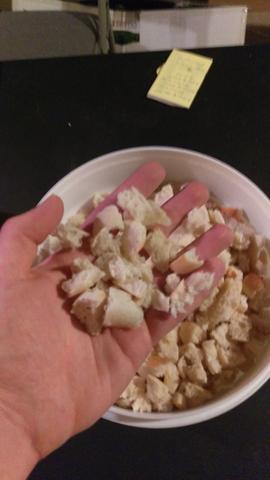
I decided to keep the recipe for this experimental batch very basic, as I want to be able to observe the flavor and effect of the breadsticks very clearly. A 2:1 ratio of plain 2-row to prepared breadstick material seemed appropriate. For a 5 gallon batch, I settled on 6 lbs and 3 lbs, along with a few fistfuls of rice hulls.
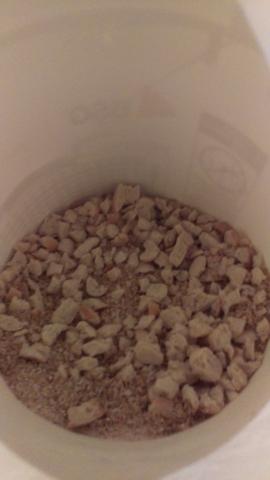
I don't usually use a protein-rest in my brews, but given the amount of, erm.... weird stuff going into this one, it seemed prudent. I doughed-in at 123.6° F, a little higher than my target of 122°. Since I am limited by my plastic MLT to doing multiple infusion mashes, my initial mash was quite thick.
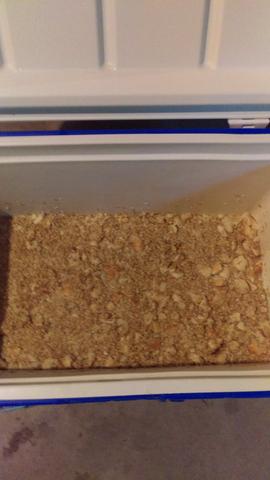
One of the first things that I noticed was that the breadstick bits wanted to float on top of the rest of the mash. This made me a little concerned about actually extracting anything from them, but gave me hope that the sparge wouldn't stick solid. I grossly missed my temperature on my first attempt at bringing the mash up to the saccharification rest, and had to give it another infusion of boiling water to hit 148.5°. By this time it was looking a bit more like a normal mash.
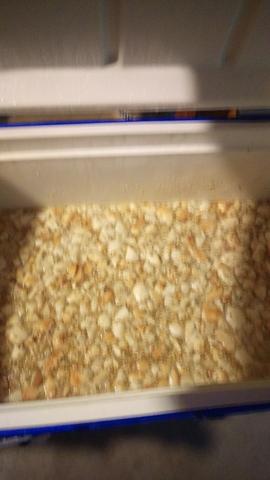
Beer gods be praised, I didn't have any problems with runoff. Well, other than the fact that I opened the valve on my HLT way too wide and turned my back on it. What should have been a slow, steady fly-sparge turned into a not-quite-batch-sparge in under 10 minutes. Oh well, worse things have happened. The wort ran off very pale. Even the first runnings were golden straw.
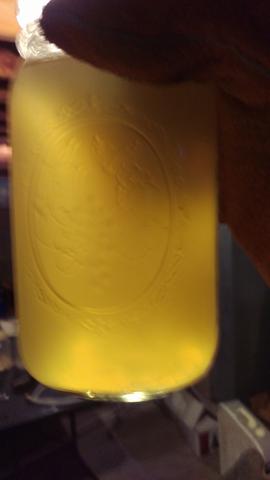
During the boil I threw in some Boadicea hops I had lying around in the freezer. Again, hops weren't meant to be the star of the show here.
The moment of truth was in taking the gravity reading. 1.053, a good sign that the bread had contributed something. Assuming 85% efficiency, Beersmith says that the 2-row would have only gotten me to 1.038. Even 100% and I would have only hit 1.044. Now we wait and see if that something is the sort of something that yeast can eat.
Back in the July-August edition of BYO there was an article about a U.K. brewery that uses toast as an adjunct in their beer. I work at a pizza shop where we routinely throw out large volumes of unused bread, specifically breadsticks, and it got me thinking that maybe I could put some of that waste to use. After all, if I can get something for free and turn it into beer, why would I not give it a go? Would I actually be able to extract fermentable sugar from waste bread? Would I create a giant, unlauterable mass of dough in my mash tun? There was only one way to know.
The next weekend I cooked off a bunch of the extra sticks and brought them back to the workshop. After giving them a few days to go good and stale, I cut each of them in half and laid them out on a baking sheet. The sheets went into the oven at the lowest setting for 20 minutes or so, long enough to dry the bread out completely and give it a very light toast. The next step was to break them apart into smaller, mashable pieces. After mangling my hand with a serrated knife, I broke down and had my girlfriend teach me to use the food processor.

I decided to keep the recipe for this experimental batch very basic, as I want to be able to observe the flavor and effect of the breadsticks very clearly. A 2:1 ratio of plain 2-row to prepared breadstick material seemed appropriate. For a 5 gallon batch, I settled on 6 lbs and 3 lbs, along with a few fistfuls of rice hulls.

I don't usually use a protein-rest in my brews, but given the amount of, erm.... weird stuff going into this one, it seemed prudent. I doughed-in at 123.6° F, a little higher than my target of 122°. Since I am limited by my plastic MLT to doing multiple infusion mashes, my initial mash was quite thick.

One of the first things that I noticed was that the breadstick bits wanted to float on top of the rest of the mash. This made me a little concerned about actually extracting anything from them, but gave me hope that the sparge wouldn't stick solid. I grossly missed my temperature on my first attempt at bringing the mash up to the saccharification rest, and had to give it another infusion of boiling water to hit 148.5°. By this time it was looking a bit more like a normal mash.

Beer gods be praised, I didn't have any problems with runoff. Well, other than the fact that I opened the valve on my HLT way too wide and turned my back on it. What should have been a slow, steady fly-sparge turned into a not-quite-batch-sparge in under 10 minutes. Oh well, worse things have happened. The wort ran off very pale. Even the first runnings were golden straw.

During the boil I threw in some Boadicea hops I had lying around in the freezer. Again, hops weren't meant to be the star of the show here.
The moment of truth was in taking the gravity reading. 1.053, a good sign that the bread had contributed something. Assuming 85% efficiency, Beersmith says that the 2-row would have only gotten me to 1.038. Even 100% and I would have only hit 1.044. Now we wait and see if that something is the sort of something that yeast can eat.



